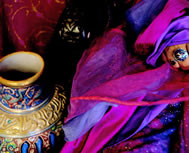




 |
    |
Reviews |
||
|
|
Dr. Stoddard MartinTo a Westerner, the Orient may be less a fact than a feeling. At present, in days of suicide bombers and anthrax, the uneducated and fearful may react to it chiefly as a source of something terrifying, or at least incomprehensible. But to an older tradition set by Byron and Flaubert amongst others, Eastern images and motifs evoked an impulse to release; to flight into light and beauty and harmony - or, as Beudelaire so transcendentally puts it in his 'Invitation au Voyage': 'Là, tout n'est-ce qu'ordre et beauté/Luxe, clame et volupté.' It is this sort of East that Carolinda Tolstoy brings back to us in her ceramics. It is why I, as publisher, chose an image of hers to go on the cover of that marvellous collection of essays 'Three Journeys in the Levant' by Shusha Guppy. Like that exemplary return to a vanishing genre of belles-lettres, Carolinda's bottle has tenderness and grace. It evokes distant dancers, the exaltation of the dervish, the mild philosophics of 'Rubáiyát of Omar Khayyám'. At the same time, it has a curious northern grounding: a strength as if purloined from under the onion dome of a lone Orthodox cupola, standing in luminous snowdrifts beneath a Russian winter's clear dawn. Whatever their technical qualities, whatever their achievement in resurrecting lost forms of art, Carolinda Tolstoy's ceramics are little grains of literary impression. Like certain wall-hangings or carpets for Somerset Maugham, they may entrance the viewer into intimations of larger patterns - to his own life, say, or to history. There is a quality here reminiscent of some types of late romantic music - the Wagnerian or Mahlerian strains that sent symbolist poets deep into reveries where pools of exotic images lurked. We may hear the exquisite plaint of Debussy's 'Faune', or perhaps (and of course!) the narrative weavings of 'Asie' or 'Schérhézade'. How grateful one is for the experience - and that Carolinda Tolstoy has been so ardent and true to her aesthetic star as to create work that can restore us to such apparently evanescent inklings. © Dr. Stoddard Martin
|
 |
| © Carolinda Tolstoy 1999-2018 | Web site design: QuincDigital |